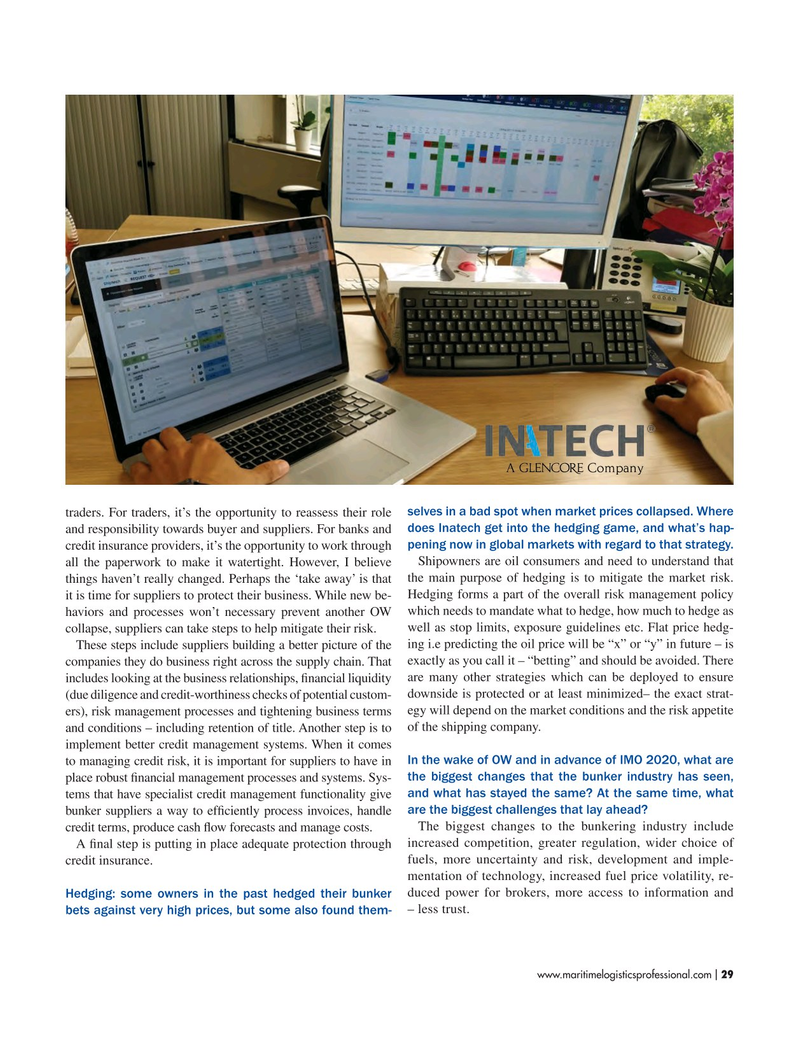
Page 29: of Maritime Logistics Professional Magazine (Jul/Aug 2017)
PORTS & INFRASTRUCTURE
Read this page in Pdf, Flash or Html5 edition of Jul/Aug 2017 Maritime Logistics Professional Magazine
traders. For traders, it’s the opportunity to reassess their role selves in a bad spot when market prices collapsed. Where and responsibility towards buyer and suppliers. For banks and does Inatech get into the hedging game, and what’s hap- credit insurance providers, it’s the opportunity to work through pening now in global markets with regard to that strategy.
all the paperwork to make it watertight. However, I believe Shipowners are oil consumers and need to understand that things haven’t really changed. Perhaps the ‘take away’ is that the main purpose of hedging is to mitigate the market risk. it is time for suppliers to protect their business. While new be- Hedging forms a part of the overall risk management policy haviors and processes won’t necessary prevent another OW which needs to mandate what to hedge, how much to hedge as collapse, suppliers can take steps to help mitigate their risk. well as stop limits, exposure guidelines etc. Flat price hedg-
These steps include suppliers building a better picture of the ing i.e predicting the oil price will be “x” or “y” in future – is companies they do business right across the supply chain. That exactly as you call it – “betting” and should be avoided. There includes looking at the business relationships, fnancial liquidity are many other strategies which can be deployed to ensure (due diligence and credit-worthiness checks of potential custom- downside is protected or at least minimized– the exact strat- ers), risk management processes and tightening business terms egy will depend on the market conditions and the risk appetite and conditions – including retention of title. Another step is to of the shipping company. implement better credit management systems. When it comes to managing credit risk, it is important for suppliers to have in In the wake of OW and in advance of IMO 2020, what are place robust fnancial management processes and systems. Sys- the biggest changes that the bunker industry has seen, tems that have specialist credit management functionality give and what has stayed the same? At the same time, what bunker suppliers a way to effciently process invoices, handle are the biggest challenges that lay ahead?
credit terms, produce cash fow forecasts and manage costs. The biggest changes to the bunkering industry include
A fnal step is putting in place adequate protection through increased competition, greater regulation, wider choice of credit insurance. fuels, more uncertainty and risk, development and imple- mentation of technology, increased fuel price volatility, re-
Hedging: some owners in the past hedged their bunker duced power for brokers, more access to information and bets against very high prices, but some also found them- – less trust.
www.maritimelogisticsprofessional.com 29
I

 28
28

 30
30
